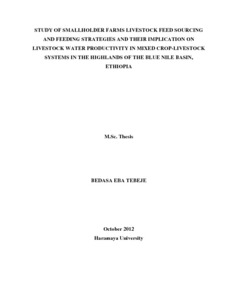Resource information
This study was conducted to assess livestock feed sourcing and feeding strategies and their implications on livestock water productivity (LWP) in mixed crop-livestock production systems of the Blue Nile Basin (BNB) in Ethiopian Highlands. Three Woredas (Diga, Jeldu and Fogera) representing diverse agricultural farming systems were considered. One watershed in each Woreda, which is Dapo from Diga, Meja from Jeldu and Mizuwa from Fogera were selected. Each watershed further stratified to different farming systems depending on cropping pattern and landscape positions. Accordingly seven farming system has been identified. Diga has teff-millet and maize-sorghum farming systems; Jeldu has barley-potato, teff-wheat and teff-sorghum farming systems; and Fogera has teff-millet/maize and rice-pulses farming systems. A multi-stage stratified random sampling technique was employed to select farm households. A total of 220 household were selected: where 67 household from Diga, 91 household from Jeldu and 62 household from Fogera Woreda. A structured questionnaire, group discussions, plant biomass sampling, literature and survey were done to generate data on farmers feed sourcing and feeding strategies. To estimate livestock water productivity, water depleted (evapotranspired) for livestock feed was estimated using reference evapotranspiration and crop coefficient and then LWP was estimated as a ratio of livestock’s beneficial outputs and services to depleted water. The results indicated that the major feed sources in the BNB were mainly from natural pasture and crop residues. Improved feed sources including those with denser metabolisable energy were not reported. The share of crop residues on dry matter basis was highest in all study sites. In the study farming system the contribution of crop residues to livestock feed sourcing varied among farming systems and it ranged from 58.5% to 78.2%. Generally access to crop residues by the households is a function of crop composition and productivity at farm scale and thus varies across study systems. For example in Diga and Fogera, the dry matter of crop residues per household were greater for maize-sorghum and rice-pulses systems, respectively at P<0.05. Similarly dry matter from private grazing land showed significant differences among the farming systems in Jeldu and Fogera at P<0.05. The feed storage, feeding strategies and utilization techniques were relatively similar among the study farming systems but the magnitude varies in Woredas. In response to low biomass yield feed deficit in terms of metabolisable energy predominated in all farming systems, except maize-sorghum system of Diga. The water depleted for feed production (m3ha-1) and feed water productivity (FWP) (kg m-3) were greater for maize-sorghum and rice-pulses systems of Diga and Fogera Woreda, respectively at P<0.05. FWP for Jeldu systems was also differed (P<0.05). The productivity of livestock per TLU (US$ TLU-1) was greater only for maize-sorghum system in Diga at P<0.05. There was no significance difference (P>0.05) observed in LWP within all Woreda between the farming systems, and the value falls between 0.15-0.19 US$ m-3. However, when farm households clustered into wealth status difference of LWP was observed within all farming systems (ranges 0.08-0.24US$ m-3) and lower value of LWP general observed for the poor farm households. Such big gap of LWP for farm households operating in the same farming system suggests a potential for improvements. Such big differences of LWP values among farm household can be accounted for by the strategies farm households are following in feed sourcing and how water productive those feed sources are. Although divergences in feeding strategies and livestock beneficial outputs were not vivid, among the systems, empirical evidences suggests that these are also a good entry points to improve LWP. Hence, in the context of this work, options to improve LWP mainly involve sourcing water productive and higher quality feed.


